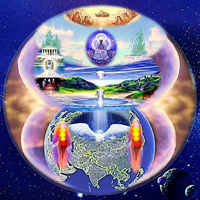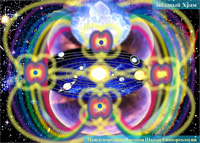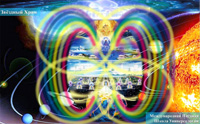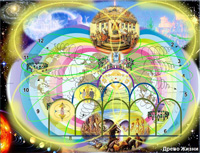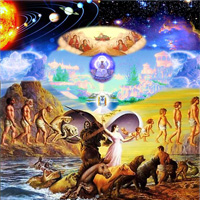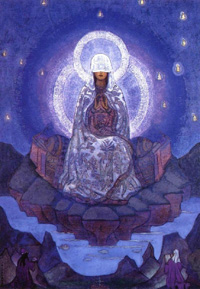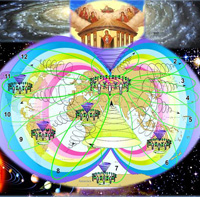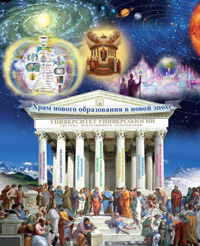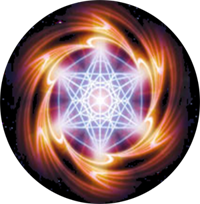Calendar
| Mo | Tu | We | Th | Fr | Sa | Su |
|---|---|---|---|---|---|---|
| 1 | 2 | 3 | 4 | 5 | 6 | 7 |
| 8 | 9 | 10 | 11 | 12 | 13 | 14 |
| 15 | 16 | 17 | 18 | 19 | 20 | 21 |
| 22 | 23 | 24 | 25 | 26 | 27 | 28 |
| 29 | 30 | 31 |
Moon Phase

Banners
| The Fundamental Principles of Interdisciplinary Science Universology |
|
Page 2 of 5
Universology in Figures and Numbers. Quantity and Quality. Seven basic principles of Hermes Trismegist were manifested in tenfold way of a man’s development. That’s why the Arabs put the number 10 as the basis of all calculations as the relations of a system and a subsystem (3+7). And one should take into account that the system has its purpose as the orientation stated by the bigger system. The scheme of the algorithm of calculation and the principle of self-management in micro- and macrocosm one should perform as such interconditionality: subsystem–system–supersystem. Universology proves that the statement about three whales and 4 elephants on which the Earth is lying is not the myth but scientific fact presented allegorically. It was grounded on the example of seven levels of cause-and-effect scheme: 3 are the causative sphere (3 whales) and 3 are the sphere of effect + 1 (which is the transitional level) is four, i.e. 4 elephants. Comparing with the present-day science the ancient sciences were built on another principles of investigation of the Universe and society. The difference is that the ancient scientists used the figures not only to determine quantity but also to get qualitative characteristics adequate to the number of stages of cycle construction of system relations. This thesis illustrates the universal laws of system structure and cyclicity of its development. The structure of a system has 10 levels taking into account that it includes a subsystem with 7 levels (7+3=10). And each level has its concrete characteristics. Thus all the calculations done with the help of figures and numbers are the operations with the systems of definite levels. Picture. The illustration of regularities of systems expressed by figures from the viewpoint of their quality. The figures characterize the number of the level and the number of the stage of life system development: a) full structure of the system with its 10 levels including its subsystems with 7 levels; b) on each level of the system repetition of the full structure of the lesser level systems (i.e. subsystems) with their 10 levels. As far as the universal laws are repeated on all levels in subsystems and supersystems the ancient thinkers introduced: 1) for subsystems – the figures after comma – decimal and so on; 2) for supersystems the figures: a) as the order of supersystems – 100,1000.etc.; b) as the transition from one level to another, e.g.: 11,12,13…20,21,22…121,122… So did the figure rows as transitional process and connection between the system of different levels appeared. Mathematics created the powerful apparatus. And from now with the help of Universology the calculations will obtain not only quantative characteristics but also the qualitative one: 1 –the primary source; 2 – dualism of relations; 3 – causative connection and selfmanagement… At the same time on the example of Mendeleev’s table the microvorld demonstrates the repetition of the Universal Laws in organization of matter of small forms of life – the atoms.
Thus the Universal Laws is the force supporting the development of life according to the Universal scheme manifestating in different space-and-time continuums (stages, levels) and it creates the individuality of systems of life of micro- and macrocosm. Consequently on every level of micro- and macrocosm the Universal Laws show themselves by means of the Universal regularities of the matter of space and the time of its development. It is their interconditionality that is the system of the world construction. Thus white forming mutual relations between any phenomena of being the definite system appears. This system manifestates the dualism of relative simultaneity of its development: 1) as the structure of space forming the interrelations of the system elements and 2) as the cycle of step-by-step forming of the given structure in time. Space * Structure of Life Systems. Space of systems is formed as the structure of cause-and-effect relations of different phenomena of surrounding world in the development cycle of the given system. And the trinity (or 3 whales) appears: 1) the cause of different phenomena – the sphere of causes; 2) manifestation of the cause – is the sphere of effect; 3) the transition process from the sphere of cause to the sphere of effect.
Picture. The structure of development of systems of any level of manifestation in the surrounding world. The sphere of cause is the very space where the managing influence (e.g.: idea, thought, brain, direction etc.) is formed. The sphere of effect is the space which the managing influence is aimed at (e.g. a group of people, the workers of an enterprise, the organs of the body, etc.). The transition process is the space of interconnection of cause and effect. For example, let’s take a man’s organism. The transition process from brain management to the organs and cells is provided by 4 systems of the organism: (the nervous system, respiratory system, the system of blood circulation, digestive system). It is like the technological process providing the connection between the managing system (direction) and the units of an enterprise. Both the sphere of cause and the sphere of effect are also characterized by the same trinity (but as the systems of lesser level). For example, the relations between the stuff and its member should be realized as the relations between the system and its subsystem. It determines the essence of the system’s manifestation as the structure of 7-levels relations where 3 levels are the sphere of effects, 3 levels are the sphere of causes and the fourth level is the transitional one between them.
At the same time the cause-*-effect relations are performed as subject-object system relations that are psychosystem and are the basis of psychosystemology. Let’s study the characteristics of 7 levels of any system. The 1st level is the structureforming of the system from its subsystems. The 2-nd is the integration of subsystems. The 3-th is self-management of subsystems in the system. The 4-th is the transitional one. It realises the interconnections of the created system with another systems. The 5-th means the intersystem structureforming and management of subsystems. The 6-th is integration and hierarchical systematization of systems. The 7-th means intersystem management and the transition process to supersystem.
The purpose of supersystem |
